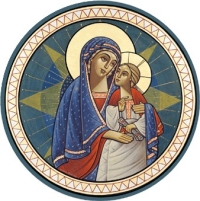Aber mit der Heimat
geht man immer herum,
durch die Welt,
dort und dort
Peter Handke
No one could describe
the Word of the Father;
but when He took flesh from you, O Theotokos,
He consented to be described, and restored the fallen image to its former beauty.
We confess and proclaim our salvation in word and image.
Kontakion of the Triumph of Orthodoxy

Reminds me of the Christian band in the Simpsons who crossed over into the secular industry by just replacing the word “Jesus” with “baby” in all their songs. Perhaps Mariah Carey could do the same thing in reverse? ;-)
I found this very funny but also rather embarrassing, because I don’t really know how you tell a Calvinist from other kinds of Christian (apart, presumably, from their fanatical loyalty to J[ohn] C[alvin]). What is the acid test? Can anyone help me out, or is my ignorance invincible?
Wikipedia is your friend Robert.
Given that its present form has multiple main tributaries, the name “Calvinism” is somewhat misleading if taken to imply that every major feature of the doctrine of the “Calvinist churches”, or of all Calvinist movements, can be found in the writings of Calvin. Others are often credited with as much of a final formative influence on what is now called “Calvinism” as Calvin himself is – for example Calvin’s successor Theodore Beza, the Dutch theologian Franciscus Gomarus, the founder of the Presbyterian church, John Knox, and any number of later figures such as the English Baptist John Bunyan and the American preacher Jonathan Edwards.
Despite the various contributing streams of thought, a distinctive issue in Calvinist theology that is often used to represent the whole is the system’s particular soteriology (doctrine of salvation), which emphasizes that humans are incapable of adding anything to obtain salvation and that God alone is the initiator at every stage of salvation, including the formation of faith and every decision to follow Christ. This doctrine was definitively formulated and codified during the Synod of Dort (1618-1619), which rejected an alternative system known as Arminianism.
Calvinism is sometimes identified with “Augustinianism” because the central issues of Calvinistic soteriology were articulated by St. Augustine in his dispute with the British monk Pelagius. In contrast to the free-will position advocated by Charles Finney and other dissenters (often labeled Pelagians or Semipelagians), Calvinism places strong emphasis, not only on the abiding goodness of the original creation, but also on the total ruin of human accomplishments and the frustration of the whole creation caused by sin, and it therefore views salvation as a new work of creation by God rather than an achievement of those who are saved from sin and death.
More broadly, “Calvinism” is virtually synonymous with “Reformed Protestantism”, encompassing the whole body of doctrine taught by Reformed churches. The Reformers did not dwell on predestination as if it were a central dogma, but advocated the preaching of “the whole counsel of the Word of God.” In addition to maintaining a Calvinist soteriology, covenant theology is the architectural structure of the whole system incorporating all loci of doctrine. In piety and practice, a primary distinction is the regulative principle of worship, which rejects any form of worship not instituted for the church in the Bible and which sets Reformed theology apart from Lutheranism, which holds to the normative principle of worship.